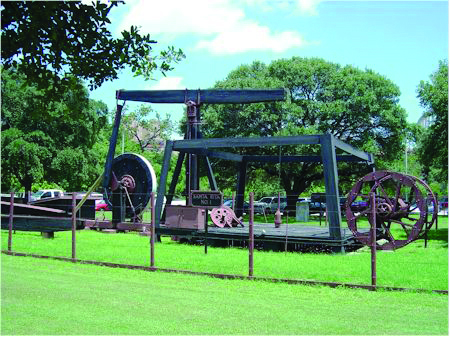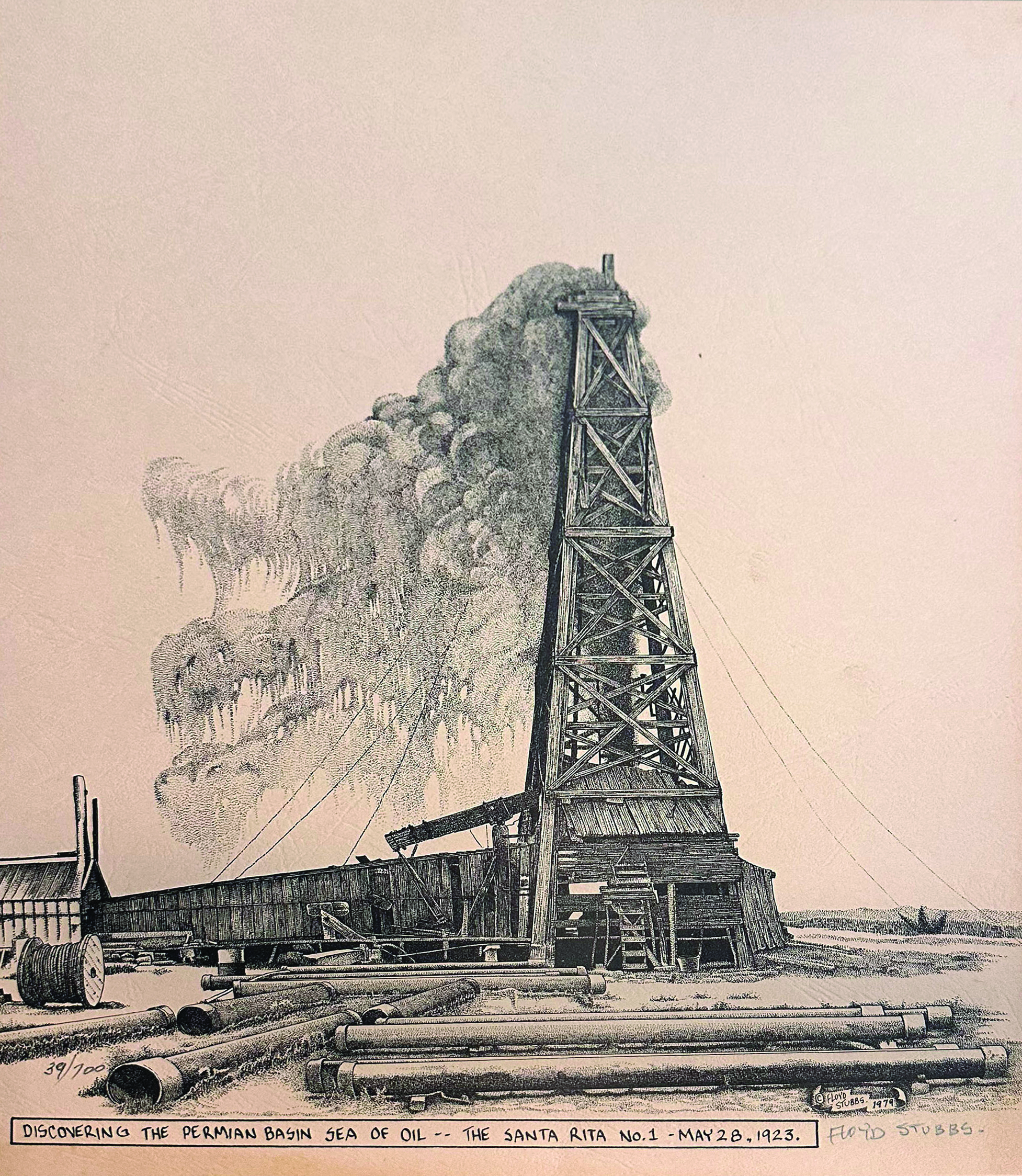Story by Deon Daugherty |Hart Energy| In the early hours of May 28, 1923, an oil well that almost wasn’t roared to life in the sparse West Texas landscape, spraying crude over the top of the derrick and covering a spread of 250 yards with the black, sticky stuff. |Read More on Permian Basin and Texas Shale Plays.
It was the Santa Rita #1 and its namesake—the patron saint of impossible things—had finally delivered to World War I U.S. Army veteran Frank T. Pickrell.
Oilmen of various expertise had been poking around in the Permian Basin since 1920 with nominal success. The W.H. Abrams No. 1 well, a small endeavor in Mitchell County, marks the beginning of the basin’s inauspicious beginnings.
But it was the Santa Rita—a producer until 1990 when it was plugged after 67 years—that put the Permian on the map and set the stage for it to become the most prolific play in the nation and among the top oil-producing basins in the world.
Located in Section 2, Block 2, on University of Texas (UT) land in Reagan County, the Santa Rita proved that oil was indeed underground. It took four years to come online after its initial promotion in January 1919 by Reagan County lawyer and World War I veteran Rupert Ricker.

Original equipment on the Santa Rita is now located within site of Memorial Stadium on the University of Texas campus in Austin. (Source: Bob McSpadden)
He and four associates applied for leases on 431,360 acres of UT land in Reagan, Upton, Irion and Crockett counties, and ponied up the $43,136 filing fee, according to the Texas State Historical Association (TSHA). The men had 30 days to promote the deal and sell enough leases to cover the fee.
But as the deadline closed in, Ricker had no takers. Pickrell, an Army buddy from El Paso, Texas, offered $2,500 for Ricker’s plans, maps, and preliminary holdings.
Promoting the acreage proved just as impossible for Pickrell as it had for Ricker. Pickrell and his partner, Haymon Krupp, opted to develop the acreage on their own. They incorporated as Texon Oil and Land Co. and sold certificates of interest in a 16-section block at $200 each for a .0004882 portion of an interest.

The Santa Rita had produced for almost 67 years when it was finally plugged in 1990. (Source: Texas State Historical Association)
The firm raised more than $100,000 and used much of the cash to rent and buy used drilling equipment. Their first test well was the Santa Rita, spudded on Jan. 8, 1921, by experienced driller Carl Cromwell, who was paid $15/day and in company stock.
For 646 days, Cromwell ran a two-man crew and bailed the hole, averaging 4.7 feet/day, according to TSHA.
It wasn’t easy work, nor was it peaceful living. The Santa Rita was next to the tracks on The Orient railroad, a track of more than 730 miles that moved freight and passengers from Kansas to Texas.
“The crews working on remote projects like the Santa Rita typically brought their families with them,” Bob McSpadden, a retired engineering technician from Shell Oil Co., said. “They usually ‘camped’ in tents nearby.”
McSpadden worked as a control electrician in McCamey, Texas, about 35 miles west of the Santa Rita, during the 1970s. He was friendly with Dee and Nora Locklin; Dee was on Santa Rita’s drilling crew.
After Dee Locklin had passed, McSpadden said he asked Nora if she was the last living person who was around when the Santa Rita well came in.
“Her reply was classic: ‘I’m the last one with any sense,’ and she left it there,” he said.
On May 27, the crew drilled into the dolomitic sands, right around 2,050 ft down into the “Big Lime.” Hours into the following day, the Santa Rita convinced area residents and scouts from major oil companies of the region’s riches.
The Santa Rita was spud in the southern part of the Midland Basin, which now produces for Permian Basin juggernaut Pioneer Natural Resources, pure-play Diamondback Energy, and supermajors Exxon Mobil and Chevron.
ADDITIONAL INFORMATION, FROM THE UNIVERSITY OF TEXAS
Why Santa Rita?
Mr. Frank Pickrell was one of the partners responsible for the drilling of the Santa Rita No. 1 . The reason for the name “Santa Rita” is best told in Frank Pickrell’s own words:
“The name of Santa Rita really originated in New York. Some of the stock salesmen had encouraged a group of Catholic women to invest in the Group I certificates. These women became a little worried about the wisdom of their investment and consulted with their priest. He apparently was also somewhat skeptical and suggested that the women invoke the aid of Santa Rita, who was the patron saint of the impossible. As I was leaving New York on one of my subsequent trips to the field, two of these women handed me a sealed envelope and told me that the envelope contained a red rose that had been blessed by the priest in the name of the saint. The women asked me to take the rose back to Texas with me — to climb to the top of the derrick and scatter the rose petals, which by then were dry, over the rig and to say ‘I hereby christen thee Santa Rita’. I faithfully followed those instructions.”
Santa Rita No. 1 – History
➡From 1917 – 1919 more than 5000 oil and gas exploration permits were issued by the General Land Office for University Lands.
➡No exploration was attempted until 1921.
➡On August 23, 1921 (just four hours prior to the expiration of the applicable permit) the historic Santa Rita No. 1 was spudded in Section 2, Block 2, University Lands, Reagan County.
➡Drilling continued for almost two years at the drill site, which was isolated by a shortage of adequate roads and limited transportation facilities. It has been said that the only sounds came from the rig, roadrunners, and rattlesnakes.
➡Finally the historic day arrived on May 28, 1923, when a rattlesnake noise began at the wellbore and changed to the sound of a wild prairie wind. Santa Rita came in with oil blowing over the top of the derrick and spraying the countryside. The first well drilled on University Lands, Santa Rita No. 1, was officially transformed into a bona fide oil well.
➡The first oil royalty payment to the Permanent University Fund was made on August 24, 1923 in the amount of $516.53.
READ NEXT: Permian in Spotlight as Energy Dealmaking Gathers Steam





